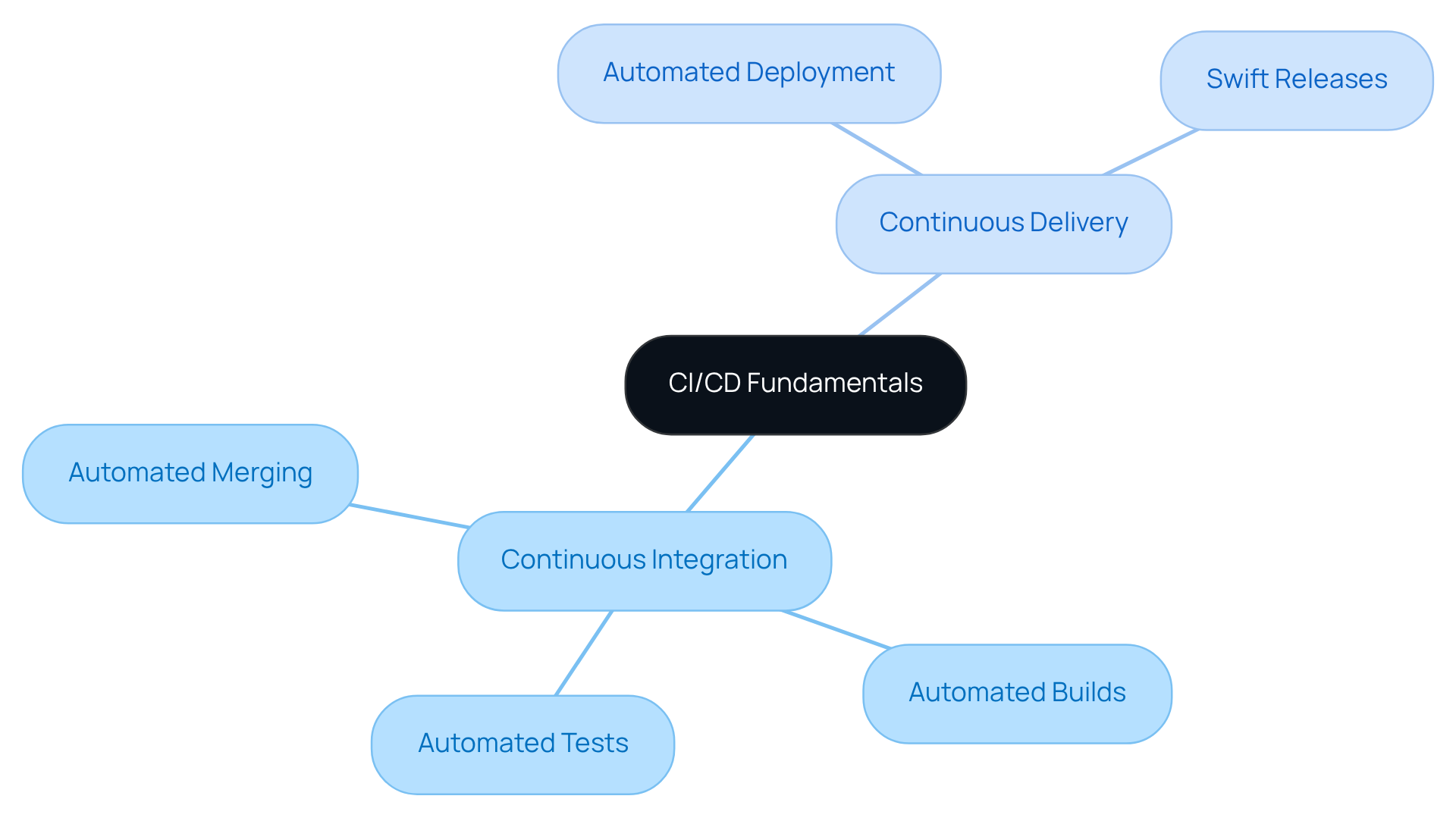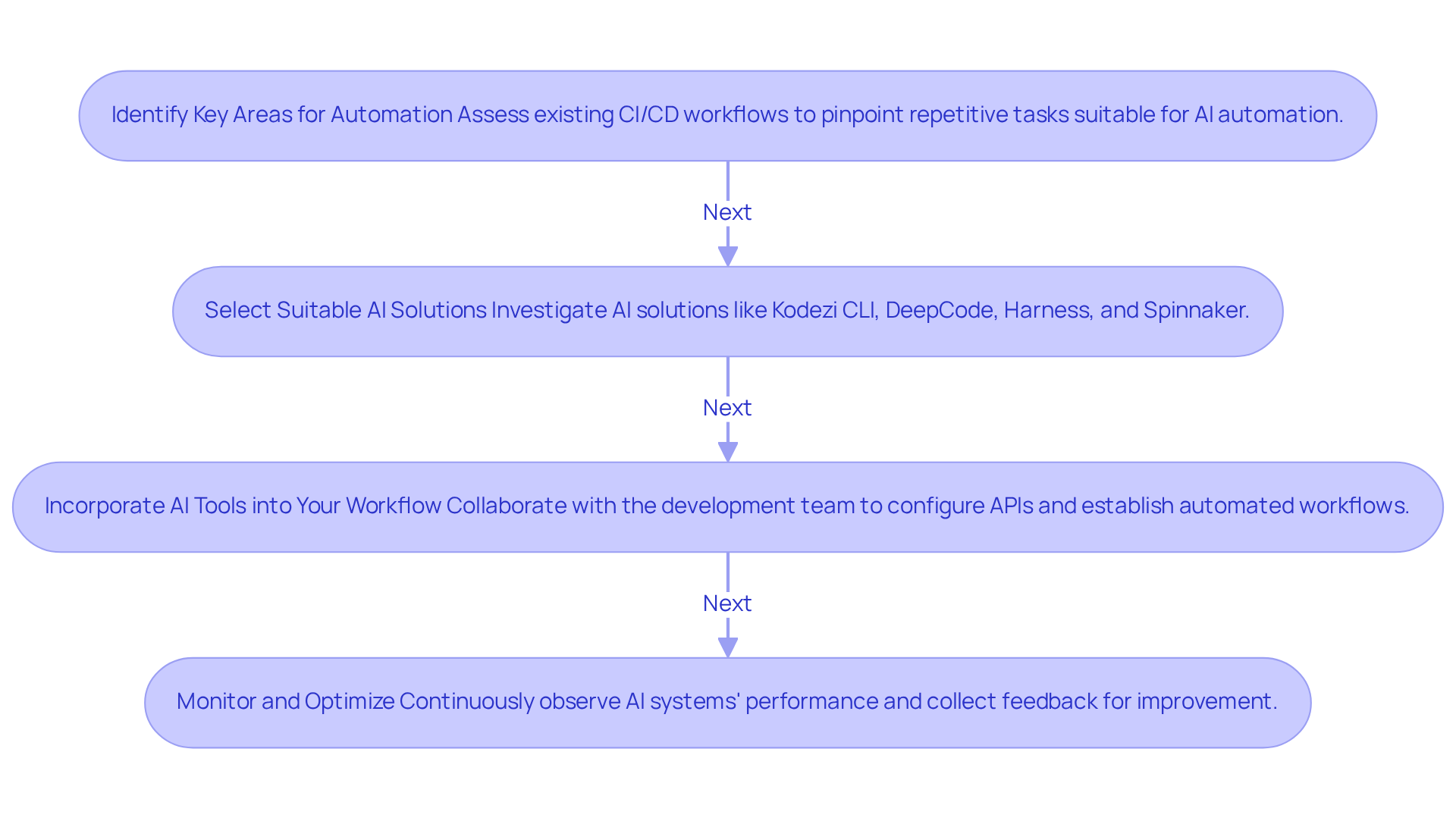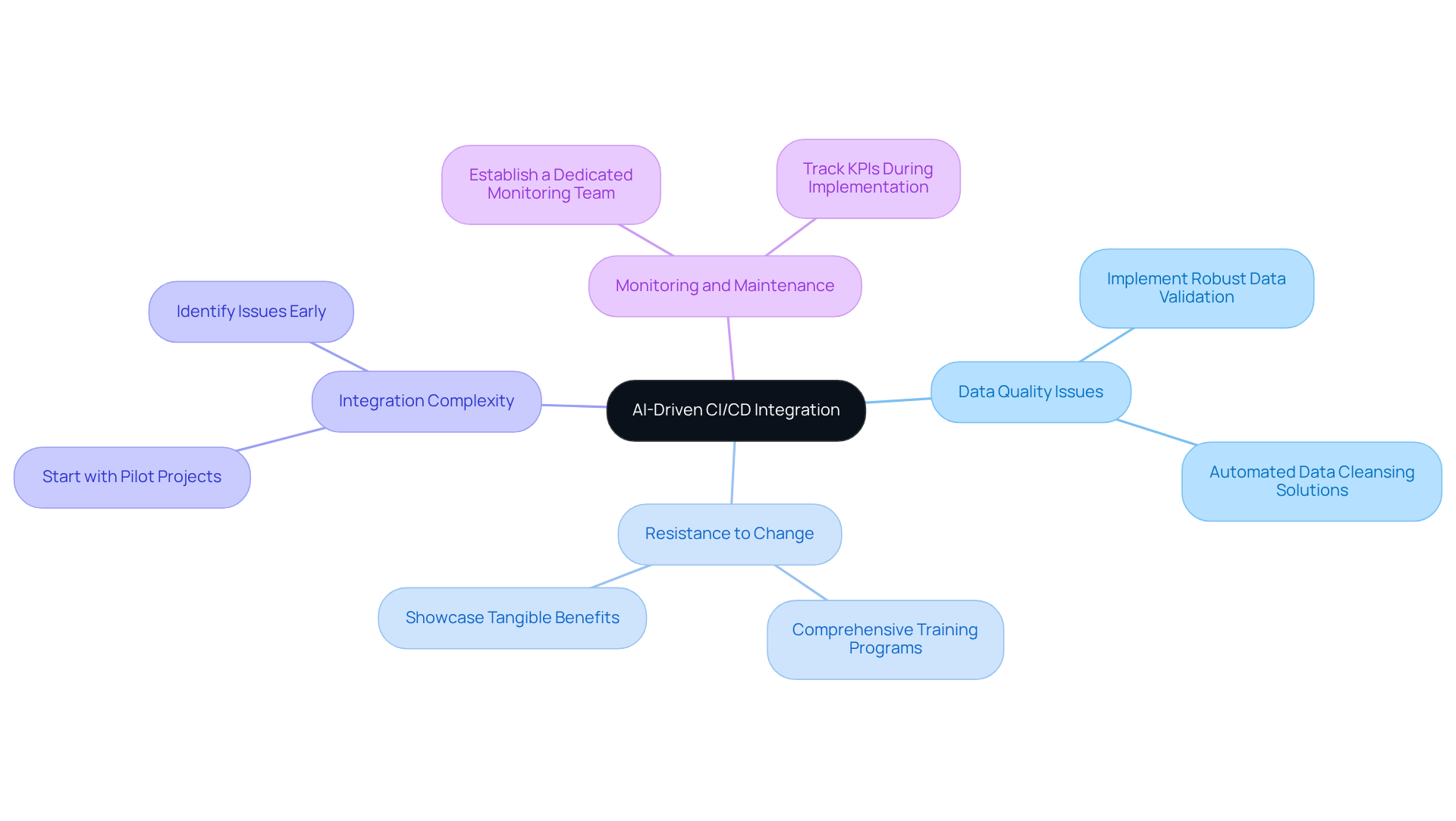Overview
The article begins by addressing the coding challenges developers frequently encounter, particularly in the realms of Continuous Integration (CI) and Continuous Delivery (CD). It highlights how AI can significantly enhance these processes, ultimately improving development pipelines.
By introducing AI-driven automation, the article elaborates on the benefits, such as:
- Predictive analytics that identify potential failures
- The automation of repetitive tasks
These advancements lead to:
- Quicker release cycles
- Better code quality
- Improved team collaboration
Furthermore, the integration of AI facilitates a more efficient workflow, allowing teams to focus on innovation rather than mundane tasks. In addition, adopting these AI tools can transform the development landscape, fostering a culture of collaboration and agility. By exploring the capabilities of AI in CI/CD, developers can unlock new levels of productivity and quality in their projects.
Introduction
In an era marked by the increasing complexity of software development, developers encounter formidable challenges in the integration and deployment processes. Continuous Integration (CI) and Continuous Delivery (CD) have become essential practices, streamlining workflows and enhancing code quality. Furthermore, this article explores how AI can automate these processes even further, providing insights into the tools and strategies that can transform development pipelines. However, as organizations eagerly adopt AI solutions, a crucial question arises: what are the key steps to successfully integrate AI into CI/CD, and how can teams navigate the inevitable hurdles along the way?
Understand CI/CD Fundamentals
In the realm of software development, developers often face significant challenges related to integration and deployment. Continuous Integration (CI) addresses these hurdles by automatically merging modifications from multiple contributors into a shared repository. This practice typically involves automated builds and tests, ensuring that new software does not disrupt existing functionality. Furthermore, Continuous Delivery (CD) builds upon CI by automating the deployment process, allowing teams to release software updates swiftly and reliably.
Together, CI and CD practices streamline the software development lifecycle, mitigate integration challenges, and significantly enhance overall code quality. As we look towards 2025, the adoption of continuous integration and continuous delivery practices is expected to rise, with data indicating that 76% of organizations are employing automation to improve their daily operations. This trend underscores the vital role of CI and CD in fostering efficient development pipelines and maintaining high software quality standards.
Understanding these principles is crucial for successfully implementing ai automate ci/cd, as they cultivate a more agile and responsive development environment. Are you ready to embrace these practices and elevate your coding efficiency?

Explore AI's Role in CI/CD Automation
In today's fast-paced development environment, coding challenges are a common hurdle for many developers. AI is set to revolutionize the way we automate CI/CD, tackling these challenges with intelligent automation and predictive analytics. Kodezi leverages AI algorithms to analyze historical build data, helping teams identify patterns that predict potential failures before they occur. This proactive approach allows for early problem resolution, significantly minimizing downtime and improving software quality.
Moreover, Kodezi's automated debugging features empower teams to promptly recognize and address codebase problems. With thorough explanations and insights into what occurred and how it was corrected, developers can resolve issues efficiently. Furthermore, Kodezi guarantees that software repositories adhere to the most recent security best practices and programming standards, maximizing performance and enhancing formatting in moments.
But how does this translate to real benefits for your team? AI automates CI/CD processes by automating essential tasks such as programming evaluations, testing, and deployment, enabling developers to focus on strategic initiatives. Consequently, organizations incorporating AI into their development and deployment processes can anticipate quicker release cycles, better code quality, and strengthened collaboration among team members.
Statistics suggest that by 2025, more than 70% of development teams will include automated tests as a fundamental aspect of their continuous integration and delivery frameworks. This highlights the increasing dependence on AI-driven solutions to enhance workflows and improve productivity. Are you ready to explore the tools available on the Kodezi platform to elevate your coding practices?

Implement AI Tools in Your CI/CD Pipeline
To effectively implement AI tools in your CI/CD pipeline, consider the following steps:
-
Identify Key Areas for Automation: Have you assessed your existing CI/CD workflows to pinpoint repetitive tasks suitable for AI automation? Frequent candidates include reviews, testing, and deployment processes, all of which can greatly benefit from automation to improve efficiency.
-
Select Suitable AI Solutions: What AI solutions best meet your specific requirements? Investigate significant alternatives such as Kodezi CLI, which independently enhances your programming environment and resolves issues before they reach production. Other resources like DeepCode for analysis, Harness for deployment automation, and Spinnaker for continuous delivery can optimize workflows and enhance code quality. It’s important to recognize that 26% of teams encounter challenges in choosing the appropriate test automation solutions, making thorough assessment crucial.
-
Incorporate AI Tools into Your Workflow: How can you smoothly incorporate the chosen AI tools into your current continuous integration and delivery workflow? Collaborate with your development team to configure APIs, establish automated workflows, and ensure compatibility with your current toolset. For instance, Kodezi OS integrates with GitHub, CI/CD pipelines, and observability platforms for seamless upgrades and fixes, enhancing overall productivity.
-
Monitor and Optimize: After implementation, how will you ensure the performance of the AI systems? Continuously observe their effectiveness and collect feedback from your team to identify areas for improvement. Regular evaluation ensures that the tools remain aligned with your evolving development needs. In fact, 55% of companies indicate automation as a key element of their quality assurance system, emphasizing the significance of ongoing improvement.
In 2025, data suggests that more than 70% of organizations will have automated their code reviews and testing procedures. This trend underscores the vital role of AI to automate CI/CD and enhance deployment efficiency. Additionally, 60% of organizations using test automation report significant improvements in application quality. As automation becomes increasingly essential, integrating AI tools like Kodezi will not only streamline workflows but also elevate overall software quality.

Overcome Challenges in AI-Driven CI/CD Integration
The challenges that developers often face arise from integrating AI to automate CI/CD. Understanding these obstacles is crucial for effective implementation. Here are some common hurdles and strategies to overcome them:
-
Data Quality Issues: AI systems rely heavily on high-quality data to make accurate predictions. It’s essential to ensure that your data is clean, well-structured, and representative of your development processes. Implementing robust data validation techniques can significantly enhance the quality of inputs fed into AI models. For instance, organizations that effectively tackle data quality challenges frequently employ automated data cleansing solutions to uphold data integrity.
-
Resistance to Change: Team members may be hesitant to embrace new resources. In fact, studies indicate that 79% of employees express distrust towards AI implementations. To foster acceptance, it’s vital to provide comprehensive training and showcase the tangible benefits of AI integration, such as improved efficiency and reduced manual workload. As Accenture highlights, "86% of CxOs are already utilizing generative AI in their work to varying extents, and almost 100% believe that this technology will have a transformative impact on both their organization and their industry as a whole."
-
Integration Complexity: The integration of AI resources can automate CI/CD systems, but it can be intricate. Start with pilot projects to test integrations on a smaller scale before a full rollout. This approach enables teams to identify potential issues early and refine processes based on real-world feedback.
-
Monitoring and Maintenance: Continuous monitoring and maintenance of AI systems are essential to ensure optimal performance. Establishing a dedicated team responsible for overseeing AI tool performance is crucial. This team should make necessary adjustments and address any emerging issues promptly. Organizations that track KPIs during change implementation achieve a 51% success rate, underscoring the importance of this practice in enhancing overall system reliability.

Conclusion
Embracing AI to automate CI/CD processes represents a transformative shift in software development, enhancing efficiency and quality across the board. Coding challenges can often hinder progress—how can these be effectively addressed? By integrating intelligent automation and predictive analytics, organizations can streamline their workflows, reduce manual errors, and ultimately deliver superior software products at a faster pace.
The article outlines the foundational principles of CI/CD, emphasizing the importance of automation in addressing common development challenges. Key insights include:
- The proactive role of AI in identifying potential failures
- The necessity of selecting suitable AI tools
- The importance of continuous monitoring and optimization of these systems
Furthermore, overcoming challenges such as data quality issues and resistance to change is crucial for successful implementation.
As the industry moves towards greater automation, tools like Kodezi can significantly elevate coding practices and improve overall software quality. What specific features does Kodezi offer to address these challenges? Organizations are encouraged to adopt these practices not only to stay competitive but also to foster a more agile and responsive development environment. The future of software development lies in the hands of those ready to harness the power of AI in their CI/CD pipelines, paving the way for innovation and excellence. Explore the tools available on the platform to enhance your coding experience and productivity.
Frequently Asked Questions
What is Continuous Integration (CI)?
Continuous Integration (CI) is a practice in software development where modifications from multiple contributors are automatically merged into a shared repository. This process typically includes automated builds and tests to ensure that new software does not disrupt existing functionality.
How does Continuous Delivery (CD) relate to CI?
Continuous Delivery (CD) builds upon Continuous Integration (CI) by automating the deployment process, allowing teams to release software updates swiftly and reliably.
What are the benefits of implementing CI/CD practices?
CI/CD practices streamline the software development lifecycle, mitigate integration challenges, and significantly enhance overall code quality.
What is the expected trend for CI/CD adoption by 2025?
By 2025, the adoption of Continuous Integration and Continuous Delivery practices is expected to rise, with data indicating that 76% of organizations are employing automation to improve their daily operations.
Why is understanding CI/CD principles important?
Understanding CI/CD principles is crucial for successfully implementing automated CI/CD processes, as they foster a more agile and responsive development environment.




